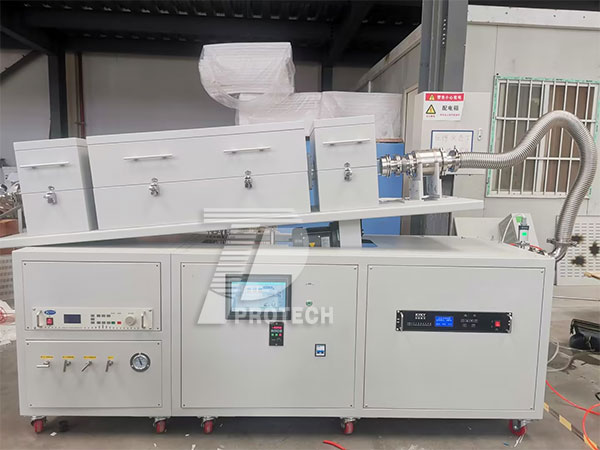


NEWS
The chemical vapor deposition (PECVD) electric furnace used in laboratories is a commonly used heat treatment coating equipment, which is highly favored by many university laboratories and industrial and mining enterprise laboratories. So, what are the characteristics and application fields of PECVD experimental electric furnaces? Let's take a detailed look below!
1. Core principles and advantages of equipment
PECVD (Plasma Enhanced Chemical Vapor Deposition) electric furnace generates plasma through glow discharge, which activates gaseous precursors (such as SiH ₄, NH3) into highly active ions or radicals, and achieves thin film deposition at low temperatures (400-500 ℃). Its core advantages include:
Low temperature process: avoids thermal damage to the substrate material caused by high temperature, suitable for flexible substrates (such as polyimide) and thin silicon wafers.
Efficient deposition: Radio frequency glow technology generates high-density plasma with a higher deposition rate, far exceeding traditional CVD.
Good film quality: By using plasma bombardment to reduce pinholes and cracks, the uniformity of film formation is high, meeting the needs of large-scale production.
Material diversity: It can deposit various dielectric films such as SiO ₂, Si ∝ N ₄, Al ₂ O ∝, etc., supporting complex structural designs such as stacked batteries and back passivation batteries.
2. Key technical parameters of laboratory equipment
Working temperature: Room temperature -1200 ℃ (single/multi temperature zone), suitable for different material deposition requirements (such as SiN ₓ requires 400-500 ℃).
Temperature control accuracy: ± 1 ℃, ensuring the stability of film growth conditions.
Vacuum system: molecular pump+mechanical pump combination, maximum vacuum ≤ 10 ⁻ ³ Pa, reduces impurity pollution, and improves film purity.
RF power supply: accurately control plasma density and optimize film performance.
Gas system: 1-6 mass flow meters (MFCs), supporting gas mixing and achieving deposition of complex component thin films (such as SiN ₓ/SiO ₂ stack).
Pressure control: Switching between positive and low pressure to adapt to different process requirements (such as low pressure deposition to reduce defects).
Intelligent monitoring: over temperature alarm, over-current protection, disconnection prompt, ensuring safe operation of equipment and reducing experimental risks.
3. Laboratory Equipment Selection Guide
Sedimentation rate and efficiency
Priority should be given to devices with adjustable RF power, supporting low-power startup (to avoid damaging the substrate) and high-power rapid deposition.
Example: When depositing SiN ₓ anti reflection film in the photovoltaic industry using a tubular PECVD electric furnace, the deposition rate is higher, meeting the demand for higher output.
Uniformity control of thin film
Choose equipment with multi-point RF feeding and uniform air path distribution to ensure better uniformity of film thickness.
Case: A certain university laboratory adopts rotary tubular PECVD to eliminate the problem of uneven plasma distribution and improve the uniformity of the film through substrate rotation.
Multi gas path and process compatibility
Support at least 2 gas mixtures (such as SiH ₄, NH ∝, N ₂ Ar), To deposit thin films with complex components.
Extension function: Some devices support the combination of ALD technology to achieve multi-layer structure.
Safety and Environmental Design
Essential functions: Over temperature protection, leakage protection, vacuum pump oil filtration system (reducing volatile organic compound emissions).
Recommendation: Choose environmentally certified equipment that conforms to the trend of green manufacturing in the laboratory.
After sales service and cost
Maintenance cycle: It is recommended to replace the vacuum pump oil and inspect vulnerable components such as seals every 3 months.
Supplier selection: Manufacturers that respond 24 hours a day to reduce equipment downtime.
4. Typical laboratory application scenarios
Research on Photovoltaic Cells
PERC cell: Deposition of backside Al ₂ O ∝/SiN ₓ laminated film to achieve dual functions of backside passivation and anti reflection, improving efficiency.
TOPCon battery: Utilizing PECVD deposition of tunneling oxide layer (SiO ₂) and doped polycrystalline silicon layer to construct efficient carrier transport channels.
Semiconductor device manufacturing
Deposition of SiO ₂ as the gate dielectric layer, adjusting the film density by controlling the RF power to reduce leakage current.
Case: A certain chip laboratory uses PECVD deposition of low stress SiN ₓ for MEMS device packaging, resulting in improved yield.
Flexible Electronics and Display Technology
Deposition of transparent conductive oxide (such as ITO) on polyimide substrate to achieve flexible touch screen preparation.
Advantages: Low temperature process avoids substrate deformation and high film transmittance.
5. Key points for equipment operation and maintenance
Installation and debugging
Strictly follow the operation manual to ensure correct electrode connection, quartz tube sealing, and vacuum pump docking.
Testing: Leakage rate testing and temperature control calibration are required before first use.
process parameters optimization
Key parameters: RF power (affecting plasma density), gas flow ratio (determining film composition), temperature (controlling reaction rate).
Routine maintenance
Cleaning: Wipe the reaction chamber with a dust-free cloth after each experiment to avoid residue contamination and subsequent deposition.
Consumables replacement: Vacuum pump oil should be replaced every 500 hours, and quartz tube transparency should be checked every 200 experiments.

Rotating tilted PECVD experimental furnace (click on the image to view product details)
Overall, the application of chemical vapor deposition (PECVD) experimental furnaces is very extensive. However, it is important to strictly follow the user manual during use to avoid unpredictable consequences. Before customizing products, it is recommended to communicate the parameters with relevant technical personnel in order to customize PECVD experimental furnaces that are more suitable for one's own experiments!Click to learn more PECVD devices! Or click on online customer service to learn more about product information!
Leave A Message